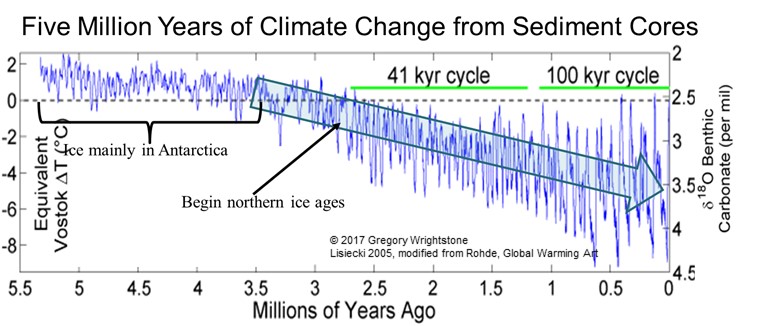Winter is Coming – And it Will be Horrific
Gregory Wrightstone
“Winter is Coming” is the motto of the House Stark in HBO’s wildly popular “Game of Thrones,” referring to the looming deep cold that will be accompanied by terror and death. George R. R. Martin’s fictional account has a real-world counterpart that will confront humanity at some time in the not too distant future and it won’t be pretty.

Lisiecki (2005) modified from Rohde, Global Warming Art
For the last ~3.5 million years the Earth has been cycling in and out of long glacial periods, punctuated by much shorter warm interglacials. For the last one million-plus years the planet has been in 100,000-year cycles of ice advance and welcome warming.
The last ice age ended about 11,500 years ago, enabling humanity to prosper and advance. The most dramatic advances in civilization took place during warm periods very similar to our own current warming trend. Over the last 150 years, we have seen a rather modest temperature increase of ~1.5°F, one that is well within the natural variations in temperature over the last several thousand years. Before climate science became politicized, such warm periods were referred to by scientists as “climate optima” because, for almost all species on Earth, warmer is better than colder.
The recurring theme of civilization’s relationship with climate is that the end of each warming period went badly for humanity. These prosperous periods were followed by declining temperatures and were times of great despair as the Earth plunged into global cooling that featured crop failure, famine and mass depopulation.
Make no mistake; bad things happen during cold periods, very bad things. The most recent cold era is referred to as the Little Ice Age (1250 – 1850) and it brought severe hardship and death. According to Ohio State University professor Geoffrey Parker, the deep cold in Europe “resulted in a series of droughts, floods and harvest failures that led to forced migrations, wars and revolutions. The fatal synergy between human and natural disasters eradicated perhaps one-third of the human population.”
Yet, as painful as episodes like the Little Ice Age were, they would be mere pikers when the next true ice age arrives. Inter-glacial cooling periods like the Little Ice Age were the result of less than 6°F cooling, while the onslaught of true glaciation would be accompanied by temperature declines of 15 to 20°F.
The next ice age would be a horrific catastrophe for human civilization. If the most recent glacial advances are an indicator of what we may see in the future, prospects for humanity are bleak. Large portions of North America, Asia and Europe will be covered in many hundreds or thousands of feet of ice. Colder temperatures will cause massive crop failures and famine, and mass migration from cold to warm regions would be inevitable.
It would take only a few years of global crop failure from cold weather to cause tens of millions of deaths worldwide. In North America alone, ice would eventually cover areas that are now home to 85 million people in the United States and another 35 million in Canada. Nearly all of Canada and most of the Scandinavian countries might eventually need to be abandoned to the ice.
When is the next glacial advance expected? Interglacials typically last 10,000 to 12,000 years and we are now nearly 12,000 years into our current one. The authors of a detailed analysis of Antarctic ice cores reported that our current interglacial is “by far, the longest stable warm period recorded in Antarctica” during the past 420,000 years. So the next glacial advance and the accompanying true climate catastrophes may arrive in the next hundred or so years or we may be spared an icy apocalypse for more than a thousand years. However, it is coming.
Rather than spending trillions of dollars reducing man’s carbon dioxide output to forestall a minuscule amount of warming, perhaps the nations of the world should consider determining the optimal amount of carbon dioxide additions needed to help alleviate the worst of the looming icy apocalypse.
